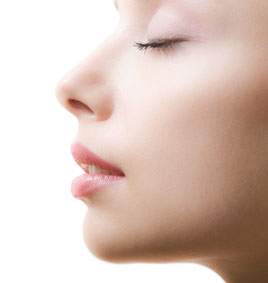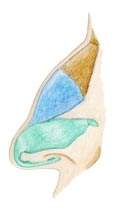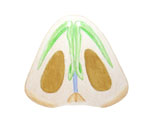Cosmetic nasal surgery or nasal plastic surgery is known medically as a nasoplasty, or more commonly, as a rhinoplasty.
Nasal surgery can correct a nasal deformity and normalize the overall aesthetic image of the face, all the more because the nose plays a central role in the aesthetics of the face.
Typical nasal deformities include the long nose, the hook nose, the nasal hump, the broad nose, among others. A saddle nose occurs most commonly in those with an Asian background, and in Europeans it is usually caused by a broken nose (fracture of the nasal bone). Functional conditions, such as impaired nasal breathing, are frequently present and must be considered during nasal correction.
A deviated nasal septum can lead to impaired nasal breathing, but doesn’t necessarily have to. There are a whole host of people with severe malalignment of the nasal septum whose nasal breathing is not impaired. In the forefront of this article is the cosmetic rhinoplasty.
Content
Yuveo Klinik
Characteristics of a rhinoplasty
Shape the nose esthetically: This is possible in many ways: from a small procedure without surgery to complex surgical correction of the nose.
Nasal Hump Correction
Correction of the nasal alar wings
Nasal Septum
How a rhinoplasty is performed
A rhinoplasty is challenging because of the complex structure of the nose. The nose is composed of several cartilages and bones that, in close interconnection with each other and the skin structure, make up its outer aspect.
Even in a minor rhinoplasty, various structures must often be modified. At the beginning of this chapter, the basic principles will be addressed, and, later, special points will be highlighted.
The following key points can be emphasized in regards to the cosmetic rhinoplasty
- The nasal hump correction or nasal hump removal is the most common form of rhinoplasty.
- The dorsal augmentation (building up the bridge of the nose) is done primarily for Asians.
- Nasal tip rhinoplasty: a precise molding is usually more successful using open nasal surgery.
- Correction of the nasal alar wings (alar cartilages) is considered to be a minor corrective opportunity that can be carried out under local anesthesia without difficulty.
- Septoplasty (nasal septal repair) – straightening the nasal septum: especially with difficulty breathing through the nose
Open or closed rhinoplasty?
The pictures show the incision lines for the open rhinoplasty: the dotted line is the incision line inside the nose. With closed nasal surgery, only the area of the dotted line on the inside will be cut.
A closed rhinoplasty has the advantage that it will leave no external visible scar. The surgeon must decide, in particular, whether a closed or an open rhinoplasty would be most advantageous. A nasal hump removal can, in many cases, be performed without difficulty using the closed technique. However, if a somewhat complex repair of the nasal tip or of the cartilaginous nasal roof is required, then the open rhinoplasty is advantageous because of the improved surgical view. The price to pay for this is a small scar on the columella, which itself is scarcely visible, even from up close. With asymmetrical, wide and high nasal tips and with noses previously operated upon, the open rhinoplasty is the safer choice. In the 1990’s, it was held to be “in vogue” to correct all noses with the closed technique. Today, the tendency for nasal surgeries is swinging back in the direction of the open rhinoplasty.
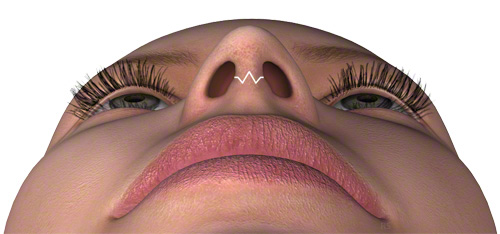
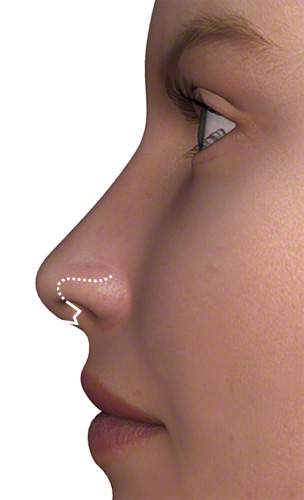
FAQ: Rhinoplasty
Which details of the anatomy are important?
Pictures: Structures that are important in the rhinoplasty. The picture on the right shows the changes in the hump nose or the long nose with a hump:
- green: alar cartilage
- blue: lateral cartilage of the nose
- brown: bony roof of the nose (nasal bones)
During the rhinoplasty, the roof of the nose must almost always be revised. The nasal roof designates the bony and cartilaginous parts of the bridge of the nose. The border between the bony and cartilaginous portions of the nasal roof is easy to palpate on the bridge of the nose. The upper third cannot be displaced laterally (sidewise). This firm area consists of the nasal bones, and, on the inside, the bony portion of the nasal septum. The area further down is more or less movable laterally and consists of cartilage. The roof here is bordered by lateral cartilage of the nose (blue). Deep to this is found the cartilaginous portion of the nasal septum.
The nose tip is shaped in the form of the alar (wing) cartilages (green), which spread out like two halves of an umbrella. These two structures are often palpable and are visible in many people.
What about the characteristics of the rhinoplasty for the Asian and African nose?
The rhinoplasty for the Asian and African nose has a few special characteristics. In contrast to the Caucasian (European) norm, a broad-based nose and a flat configuration of the bridge of the nose and nasal tip are typical. The broad base affects the bridge of the nose and alar regions as well. It is therefore self-evident that the objective of the rhinoplasty is different.
Patients often request a buildup of the bridge of the nose and the nasal tip. They often further request a lengthening of the nose and a correction of the nostrils and alar wings, so that one can no longer “look inside” the nose.
The buildup of the bridge of the nose and the nasal tip can be accomplished by means of a silicon implant, which stretches from the bridge of the nose over the nasal tip to the columella, or by means of one’s own tissue (ear cartilage, for example).
The implant or transplant can be individually trimmed to the right size and shape. After the implantation, it sits under the skin and reaches from the roof of the nose to the tip or to the columella. In this manner, a reduction of the “snub nose” effect is enabled, but it is true that a typical European nose cannot be formed.
This rhinoplasty technique is also used for European noses if, for example, an over-correction, called a saddle nose, occurs during a nasal hump repair.
What about the correction of the nasal alar wings?
Nasal alar wings that project too far and large nostrils are in principle revised as described above under correction of the nasal alar wings. Here, however a larger wedge must be removed than is the case with European noses.
For nasal wings that are badly protruding, additional suture techniques are used to attain a greater narrowing of the nostril.
This type of rhinoplasty can be performed under local anesthesia.
Can you perform a rhinoplasty without surgery?
The possibility of rhinoplasty without surgery is not as well known to most people. By means of so-called filler (filling products, such as hyaluronic acid), the irregularities can be evened out and the humps somewhat concealed. This procedure finds use for the following indications, among others:
- For less pronounced saddle noses, the bridge of the nose can be built up several millimeters. Even if irregularities exist from accidents or a procedure previously carried out, the filler offers an option for rhinoplasty without surgery.
- Smaller asymmetries can also be molded to be somewhat less obtrusive.
- Even a mildly drooping nasal tip can be concealed without surgery by injecting some hyaluronic acid into the columella, thus correcting the nasolabial fold.
- A nasal hump, though, can only be removed by means of an operative rhinoplasty. However, in the case of a smaller nasal hump, some hyaluronic acid can be injected above the nasal hump (into the so-called nasion = depression between the frontal bone and the bridge of the nose). This makes it less conspicuous.
With rhinoplasty without surgery, however, one must consider that this does not involve reduction, but only a buildup of the nasal structures. Consequently, the indications are limited, in that a contouring or a buildup of the nose is carried out, rather than a reduction.
Furthermore, the effect of the treatment is of limited duration. The life-span of the product amounts to 12-18 months, depending on the type of hyaluronic acid used.
Which role does the angle between columella and upper lip line play?
With a rhinoplasty, the angle between the columella and the upper lip (nasolabial angle) must be accounted for. This angle, which stands out in profile, plays an important role in the cosmetic appearance of the nose, and therefore the rhinoplasty. While an obtuse angle of 100 – 110 degrees is found to be aesthetic for women, this should be between 90 and 100 degrees for men.
What is nasal alar cartilage revision?
During a rhinoplasty for a nose that juts out too far (severe projection), the nostrils can at times become very large after the reduction of the roof of the nose.
Here, too, a revision is possible. A wedge is removed at the base of the nasal alar cartilages, and the resulting defect sutured in such a way that the scar is later scarcely visible, lying in the crease at the junction of the alae and the skin of the cheek.
It is important to take special care in suturing to watch for symmetry and stability, because this area is at risk during the first 2 weeks in regard to blowing and wiping one’s nose.
How is the correction of the cartilaginous nasal septum performed?
Within the scope of the rhinoplasty, the above-described correction of the nasal roof of the lateral cartilage of the nose (the cartilaginous portion of the nasal roof) is customized. Thereafter, the anterior (front) portion of the nasal septum must also be modified. As a rule, this is degraded, with resultant descent of the nasal tip and the lower portions of the nasal roof. If this is not shortened enough, a so-called parrot beak (or Polly beak) deformity can develop, meaning a crooked falling off of the lower part of the nasal bridge profile, requiring a further nasal revision. In a rhinoplasty for a long nose or a hook nose, the lower end of the nasal septum is shortened, so the nasal tip can be positioned upward.
If a deviated nasal septum with airway obstruction is involved, then the rhinoplasty must also include straightening the septum. This is possible by means of relief incisions, fixation of cartilage grafts and specially applied stitches. Only in rare cases, with a complex distortion of the nasal septum, it can be completely removed, straightened outside the body, and finally replaced.
What about removing the nasal hump?
The desire to have a nasal hump removed is one of the most common reasons for a rhinoplasty. The hump is composed of a bony and/or cartilaginous protrusion of the roof of the nose. If the nasal hump is only discretely protruding, then filing it down with a bone rasp may suffice. The removal of a large or midsize nasal hump takes place much as with a stonemason, with hammer and chisel. Here a closed rhinoplasty often suffices, if there is no reason not to use it. First, an incision is made into the cartilaginous roof of the nose. Then a special chisel is guided into this incision in the cartilage, and the excess bone on the roof of the nose is chiseled off. After the withdrawal of the chipped-off bone, the nasal roof is now open. This is called “open roof.” In order to close the roof again, the lateral bony portions on the side of the nose must be repositioned toward the midline. This can work only by breaking the base of this bone with another chisel.
What are the special characteristics of the nose tip rhinoplasty?
Within the scope of the rhinoplasty, the nose tip rhinoplasty demands the most precise work. Even small imprecisions in the placement of sutures can mean visible step-offs or disparity. For an exact correction of a moderate to severe nasal tip deformity, open nasal surgery is recommended. The nose tip rhinoplasty can also be carried out under local anesthesia. It is worth recommending accompanying sedation (twilight sleep), at least in the beginning, to make the painful injections more “harmless.”
There are as many techniques for nose tip rhinoplasty as there are grains of sand on the beach. The alar cartilage can be narrowed in the area that faces the roof of the nose. If the cartilage is weakened too much, a collapse of the vestibule on inspiration is possible, in which the air supply is restricted in an uncomfortable way. A ball-like nose tip can be corrected though stitching the alar cartilages together. So-called mattress sutures can strengthen the effect. If the alar cartilage, taken as a whole, is too widely based, it must be shortened in the horizontal direction through removal of a segment or through shifting of one half into the other. Also, it often makes sense to strengthen the columella by means of a cartilage graft to maintain stability when more marked correction is made in the area of the nasal tip.
What is involved in the postoperative care?
The type of postoperative care cannot be generalized. The variety of techniques, surgeons and patients also necessitate different types of postoperative care.
- Nasal packing
For a cosmetic rhinoplasty, packing the entire nasal cavity is not necessary, unless a large correction of the septum or the nasal muscles were performed. Small bits of support packing of spongy gauze, for instance, are placed in the anterior portions of the nose. The removal of nasal packing is not painful. - Nasal cast
If bones must be broken during a rhinoplasty, then a nasal cast is usually left on for 2 weeks. However, a splint is often applied to reduce swelling even if no bone correction is done. In simpler cases, Steri-Strips are sufficient. Today, plastic casts that are fixed over an adhesive bandage on the nose are usually used. - Stitches
After an open rhinoplasty, the stitches in the columella are removed after about 7-10 days. - General conduct
As already described, keeping the upper part of the body elevated is of value after rhinoplasty. Cooling can reduce swelling of the eyelids. Blowing the nose should be avoided, because it can negatively affect the operative result. Given that blowing or sneezing happens, then it should be done through an open mouth to lessen the pressure. When cleaning the nose, wiping should be avoided at first – dabbing is gentler. By mobilizing the crusts, swelling and bleeding can recur. Speaking too much during the first days after a rhinoplasty is bad. Protecting the mimetic (facial) muscles is helpful. - Sports
At first, the nose is still very sensitive to impact, and the bones are still not completely stable. Therefore, especially contact sports and ball sports should be avoided for 4-6 weeks after a rhinoplasty. - Molding the nose
The molding of the nose is a long-drawn out process, which is completed for the most part after about 3 months. After that only minimal changes are noted. With very large or long noses after a rhinoplasty, a lot of patience is necessary in regards to contraction of the excess skin.
What complications can occur in cosmetic nasal surgery?
In the following, the most important complications that can occur with a rhinoplasty are briefly described:
- Swelling
After a rhinoplasty, there can be severe swelling in the areas of the upper and lower eyelids, the cheeks and the mid forehead. Of course, that is also dependent on the severity of the surgery. To minimize the swelling, measures to reduce swelling are helpful: cooling, elevation of the upper body during sleep and appropriate medications. - Hematomas
The above described swelling after rhinoplasty often leads to bruising of the skin. A true hematoma, which lies in the subcutaneous tissue, is the exception. - Bleeding
This is avoided, as a rule, by use of careful hemostasis and compression. If severe bleeding occurs in the nasal cavity, the vessels are sclerosed by means of electrocautery, and the nasal cavity then generously packed. - Disturbance of feeling in the skin after rhinoplasty
Impairment of skin sensation is typical in the standard rhinoplasty. Because the skin of the bridge of the nose must be detached from the bones in order to correct it, the smallest nerves of the skin are also severed. Therefore the bridge of the nose is numb at first. It takes months for skin sensation to return. - Disturbance of scar formation after nasal surgery
So called hypertrophic scars (or, in the worse cases, keloids) are quite unusual in the nasal area. - Injury to neighboring structures (very rare)
- Injury to the olfactory nerve (n. olfactorius) by deep dissection.
- Incision of the maxillary sinus/frontal sinus.
- Infections
Infections are decidedly rare after rhinoplasty. - Tearing of the wound / sutures.
With an open rhinoplasty, careful attention must be given to protect the suture line on the columella. Even a small impact can rip the fine sutures out. Incidentally, this also applies to the invisible cartilage sutures inside the nose. - Unsatisfactory cosmetic results
Before the rhinoplasty, the patient’s desires must be understood by the surgeon and the feasibility assessed. If one is supposed to conjure up a dainty snub nose from an extremely long nose with a hump, then that would be an impossible undertaking for all intents and purposes. If displeasure persists for operative reasons or because complications occurred, then generally a nasal revision is performed. - The risks of narcotics / anesthesia will not be addressed here.
What are the historical origins of the rhinoplasty?
- The inception of nasal surgery to reconstruct the nose (surgical nasal reconstruction) lies in old India (circa 6th century B.C.).
- The first open rhinoplasty done for cosmetic reasons was carried out by Jacques Joseph in 1898.
- By 1904 he had already carried out the first closed rhinoplasty using an interior approach.
Checking the facts
- Surgeon: Dr. Schumann
Treatment duration: approx. 45 min to two hours
- Anesthesia:
mini: local anesthesia complex: general anesthesia - Hospital:
outpatient or inpatient for one day - Postoperative care:
Cooling, tamponades, nasal cast, head elevation, rest - Sport:
The nose is sensitive to impact, so avoid sport for 4 to 6 weeks after surgery.
Further Information
Cosmetic chin surgery/mentoplasty/chin enhancement
It is not unusual to combine a rhinoplasty with a chin correction using a chin implant to improve the overall profile. This combination is then called profile correction or profile plastic surgery.
